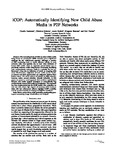iCOP: Automatically Identifying New Child Abuse Media in P2P Networks
| dc.contributor.author | Peersman, C | |
| dc.contributor.author | Rashid, A | |
| dc.contributor.author | Schulze, C | |
| dc.contributor.author | Brennan, Margaret | |
| dc.contributor.author | Fischer, C | |
| dc.date.accessioned | 2018-11-27T09:58:24Z | |
| dc.date.available | 2018-11-27T09:58:24Z | |
| dc.date.issued | 2014-05 | |
| dc.identifier.isbn | 9781479951031 | |
| dc.identifier.issn | 1081-6011 | |
| dc.identifier.uri | http://hdl.handle.net/10026.1/12906 | |
| dc.description.abstract |
The increasing levels of child sex abuse (CSA) media being shared in peer-to-peer (P2P) networks pose a significant challenge for law enforcement agencies. Although a number of P2P monitoring tools to detect offender activity in such networks exist, they typically rely on hash value databases of known CSA media. Such an approach cannot detect new or previously unknown media being shared. Conversely, identifying such new previously unknown media is a priority for law enforcement - they can be indicators of recent or on-going child abuse. Furthermore, originators of such media can be hands-on abusers and their apprehension can safeguard children from further abuse. The sheer volume of activity on P2P networks, however, makes manual detection virtually infeasible. In this paper, we present a novel approach that combines sophisticated filename and media analysis techniques to automatically flag new previously unseen CSA media to investigators. The approach has been implemented into the iCOP toolkit. Our evaluation on real case data shows high degrees of accuracy while hands-on trials with law enforcement officers highlight iCOP's usability and its complementarity to existing investigative workflows. | |
| dc.format.extent | 124-131 | |
| dc.language.iso | en | |
| dc.publisher | IEEE | |
| dc.subject | Pediatric | |
| dc.title | iCOP: Automatically Identifying New Child Abuse Media in P2P Networks | |
| dc.type | conference | |
| dc.type | Conference Proceeding | |
| plymouth.date-start | 2014-05-17 | |
| plymouth.date-finish | 2014-05-18 | |
| plymouth.volume | 2014-January | |
| plymouth.conference-name | 2014 IEEE Security and Privacy Workshops (SPW) | |
| plymouth.publication-status | Published | |
| plymouth.journal | 2014 IEEE Security and Privacy Workshops | |
| dc.identifier.doi | 10.1109/SPW.2014.27 | |
| plymouth.organisational-group | /Plymouth | |
| plymouth.organisational-group | /Plymouth/Faculty of Health | |
| plymouth.organisational-group | /Plymouth/REF 2021 Researchers by UoA | |
| plymouth.organisational-group | /Plymouth/REF 2021 Researchers by UoA/UoA04 Psychology, Psychiatry and Neuroscience | |
| dcterms.dateAccepted | 2014-11-20 | |
| dc.rights.embargoperiod | Not known | |
| rioxxterms.versionofrecord | 10.1109/SPW.2014.27 | |
| rioxxterms.licenseref.uri | http://www.rioxx.net/licenses/all-rights-reserved | |
| rioxxterms.type | Conference Paper/Proceeding/Abstract |


